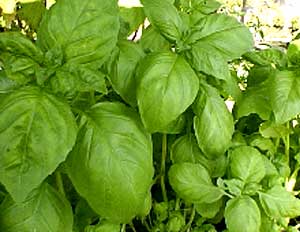|
from 30 june 2002 blue vol II, #39 |
|
|

Modern Italians use basil with everything. It is a union made in a culinary heaven when it is married to garlic and pine nuts and olive oil, a combination the Ligurians happened on a long time ago to produce their famous pesto. Basil is also commonly associated with tomato, and pesto made with sun-dried tomatoes is indescribably delicious. Basil goes well with fish, parmigiano (parmesan) and ricotto cheeses, egg, rice, pasta and soup dishes, added to the cooking or as a garnish. For the vegan however it is a herb from the Garden of Eden. It can be used as an ingredient in pastes and salads, and as a garnish with almost anything. Although basil tea is no longer popular, mixed with balm it makes a soothing, relieving drink. During the summer months basil should be a regular addition to your diet, eaten fresh from the stem as much as possible. Although basil is now abundant in small pots on our supermarket shelves, it is an easy herb to grow from seed whether you live in a Meditterranean or a Scandanavian climate. As a native of sub-tropical climes basil is a sun-worshipper with an insatible thirst when the weather gets very hot. However it grows better if allowed to dry out between waterings. In northern climates basil is difficult to grow outdoors, but it is an experience worth trying even if you live on the wet west coast of Ireland. It needs a sunny position with some shelter in rich soil that drains well. Indoors, on a window sill or kitchen shelf that gets at least six hours of sun daily, basil grows well, giving off a sweet, peppery scent - which flies hate and stay away from. The soil containing basil plants should be allowed to dry out before water and occasional feed is applied, but during the hot months your basil plants should not be allowed to dry out completely. Leaves may be picked off as soon as they are slighty over an inch and a half or three cm long. This will ensure a steady growth. The more you take the more will grow. The best variety to start from seed is the Napolitana, which you can buy easily in Italy or from specialist seed suppliers, and we don't need to emphasise that you purchase organic seeds. An annual, it dies back to the root in autumn. When using basil tear the leaves, do not cut them, and, when making pesto, pound the leaves in a mortar and pestle. Sadly or perhaps not basil cannot be successfully dried. If it is to be stored for winter use it can be steeped in olive oil where it will keep well for many months. But it is a herb that should be picked and used fresh, though the wilted leaves will, if added to a hot running bath, produce an aroma that will calm the nerves and transport you in your dreams back to a Lithurian bath-house. Pesto and Pasta with Corn Salad, Dandelion and Nettle leaves A simple easy to make dish, this is one you can make mostly from the raw ingredients or if you can't manage the effort from packaged dried pasta and pesto in a jar. The processed version can be made in ten minutes and makes a fast and nutritious meal, with a side dish of corn salad, with young dandelion and nettle leaves dressed with olive oil and balsamic vinegar. Most gardens anywhere will grow corn salad, dandelion and nettle or, if not, these leaves are freely available on market stalls and in supermarkets. If you start from stratch, see Pasta for directions on making fresh pasta, and use the following as a rough guide on making fresh pesto. There are many pesto recipes and all are worth trying (especially if you are not a dyed-in-the-wool vegan) but we are going to stick with the basic ingredients of basil, pine nuts, garlic and olive oil, and, if you think you need it, a pinch of sea salt. Pesto can be made to suit your tastes with more or less of each ingredient. A good start is 60 grammes or two ounces of basil leaves, half as much pine nuts, two cloves of garlic and 100 ml of olive oil. If pine nuts are not available walnuts are as good but use fewer because their strong taste will overwhelm the basil. The pine nuts can be softened with a fast roasting. Combine the dry ingredients in the mortar and grind against the sides until a paste is formed. Incorporate the oil. Fresh pesto can be stored but it is best made a few hours before it is needed and used in its entirety.
|
|
BLUE is looking for short fiction, extracts of novels, poetry, lyrics,
polemics, opinions, eyewitness accounts, news, features, information and arts
in any form relating to eco cultural- social- spiritual issues, events and
activites (creative and political). Send to Newsdesk. |
